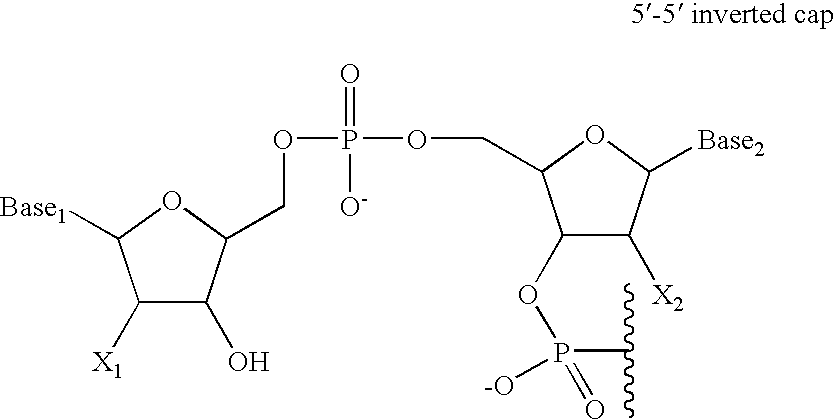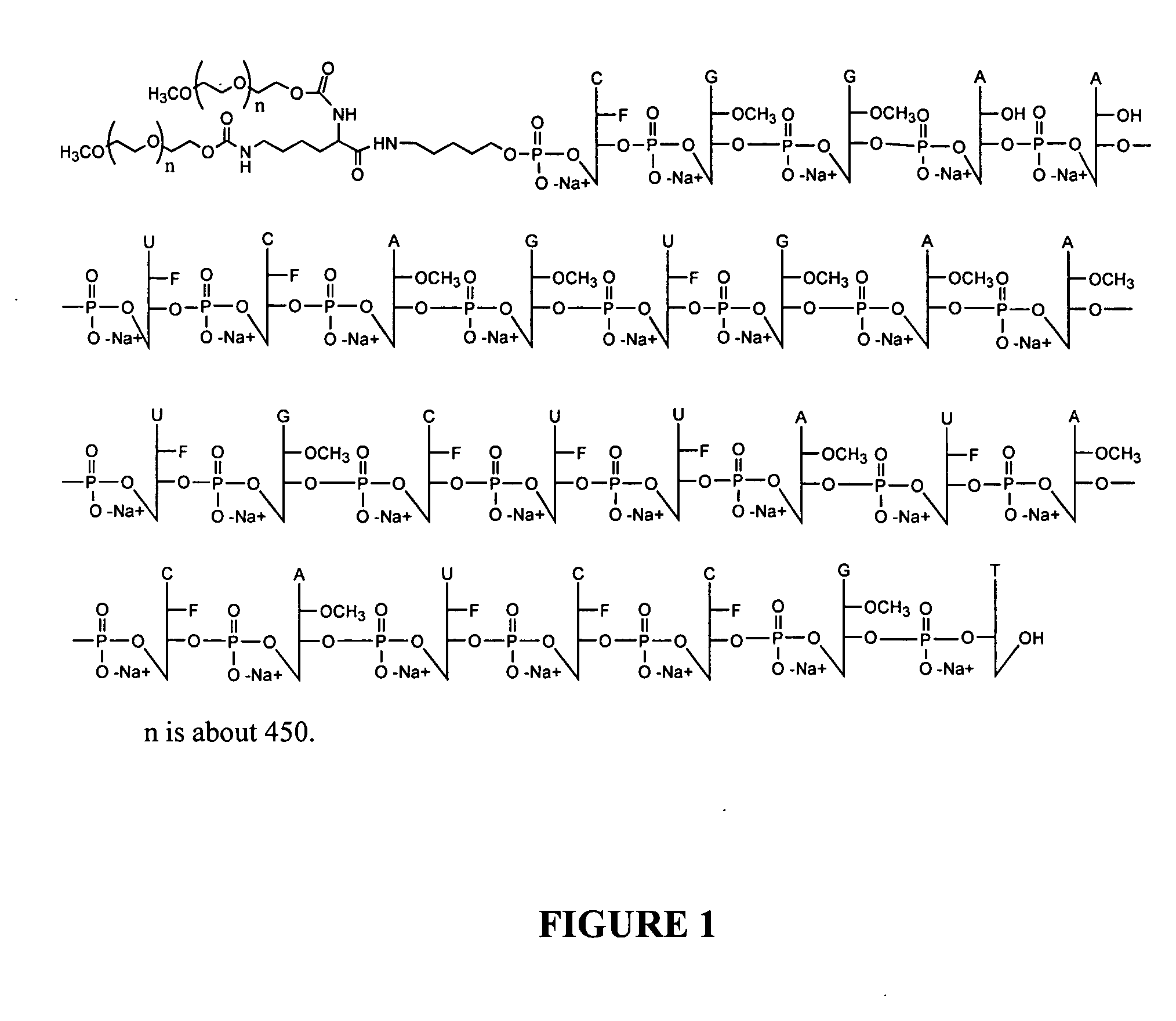Enhanced biologically active conjugates
a biologically active conjugate and conjugate technology, applied in the field of aptamers or nucleic acid ligands, can solve the problems of difficult drug delivery into the eye, unfavorable invasive intraocular administration, permanent tissue damage, etc., to avoid permanent tissue damage, facilitate iontophoretic delivery, and prolong circulation time
- Summary
- Abstract
- Description
- Claims
- Application Information
AI Technical Summary
Benefits of technology
Problems solved by technology
Method used
Image
Examples
example 1
Preparation of a 5′-PEG Conjugate of a VEGF Aptamer
[0214] The procedure is illustrated by the preparation of 40 kDa PEG / aptamer conjugate. A solution of 5′ amino aptamer (57 O.D.) was transferred to an Eppendorf tube and lyophilized to a solid. The residue was re-dissolved in 30 μL sodium borate buffer (0.1 M, pH 8.5). A solution of PEG NHS ester (1. 1 equiv., 11 mg in 30 μL acetonitrile) was added to the above aptamer solution. The resulting mixture was vortexed well and incubated at room temperature over night. The reaction was stopped by addition of water to a 2.5 mL volume. Analysis of the material by SEC HPLC indicates the aptamer (10.23 min.) was converted another species with much longer retention time (7.2 min., 75%), which belonged to the conjugate.
[0215] The mixture was desalted on a standard desalting column (Pharmacia PD-10 column). The desalted material (3.5 mL) was quantitated by UV (9.5 O.D. / mL) and concentrated to a dry powder as the crude product. The solid was r...
example 2
Preparation of a 5′-Dextran Conjugate of a VEGF Aptamer
[0216] The procedure is illustrated by making a 40 kDa dextran / aptamer conjugate. An aliquot of amino aptamer (28.6 O.D.) was lyophilized to a dry powder and re-dissolved in 100 μL 0.1 M phosphate buffer (pH 7.0). To this solution were added 40 kDa dextran (4 equiv., 20 mg), and sodium cyanoborohydride (>10 equiv, 8 mg). The solution was vortexed to get all the materials dissolved and then incubated at 60° C. overnight. The solution was then taken up by 0.5 mL 0.1 M phosphate buffer (pH 7.0). HPLC (SEC) analysis indicated the material was a mixture of the aptamer (10.8 min) and the conjugate (9.6 min., broad peak, 35%). The broad peak indicates the dextran conjugate has a wide distribution of the conjugates of different sizes. The material was desalted by a PD-10 column and the desalted material was stored in a freezer (−20° C.) until purification.
[0217] Purification was performed on a SEC column (Showdex KW 803) by injecting...
example 3
Preparation of a 5 ′-CMC Conjugate of a VEGF Aptamer
[0218] A procedure similar to that used in making dextran conjugates (See Example 2) was used to make the 5′-CMC conjugation of VEGF aptamer. A 5′-amino VEGF aptamer (28 O.D.) was lyophilized to a solid residue in an Eppendorf tube and dissolved in 0.1 M phosphate buffer (pH 7.0, 100 μL). To this was added 20 mg (3.2 equiv.) CMC. The molecular weight of the CMC was approximately 50 kDa. An additional aliquot of water (100 μL) was then added to solublize the CMC polymer, yielding a thick, viscous solution. Finally, sodium cyanoborohydride (8 mg) was added. After stirring overnight at 60° C., the reaction was stopped by diluting with water (about 2 mL) and dialyzing in water (3 times) to yield the crude conjugation material. SEC HPLC indicated the presence of the conjugated product (5.8 to 8.3 min.). Fractions corresponding to the conjugate were collected and desalted to yield the sample for functional testing. The conjugate appear...
PUM
| Property | Measurement | Unit |
|---|---|---|
| molecular weight | aaaaa | aaaaa |
| molecular weight | aaaaa | aaaaa |
| molecular weight | aaaaa | aaaaa |
Abstract
Description
Claims
Application Information
 Login to View More
Login to View More - R&D
- Intellectual Property
- Life Sciences
- Materials
- Tech Scout
- Unparalleled Data Quality
- Higher Quality Content
- 60% Fewer Hallucinations
Browse by: Latest US Patents, China's latest patents, Technical Efficacy Thesaurus, Application Domain, Technology Topic, Popular Technical Reports.
© 2025 PatSnap. All rights reserved.Legal|Privacy policy|Modern Slavery Act Transparency Statement|Sitemap|About US| Contact US: help@patsnap.com



